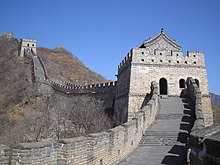The Great Wall of China has been an icon of Beijing for centuries. There has even being a saying among the locals that goes like this: If you have not been to the Great Wall, you cannot call yourself a great man (hero)未登长城非好汉 .
The
Great Wall of China is long fortified wall that was built along an east-to-west line across the northern borders of China to protect the Empire against intrusions by nomadic groups or military incursions by enemy forces. Some older walls were built during the Spring and Autumn Period and the Era of the Warring States in the early 5th to 8th century BC. The states of Qin, Wei, Zhao, Qi, Yan and Zhongshan all constructed extensive fortifications to defend their own borders. These older walls were later joined together and made bigger, stronger, and unified are now collectively referred to as the Great Wall. Especially famous is the wall built between 220–206 BC by Qin Shi Huang, the first Emperor of China, who unified China in 221 BC and founded the Qin Dynasty. To protect the empire against intrusions by the Xiongnu people from the north, he ordered the building of a new wall to connect the remaining fortifications along the empire's new northern frontier. Little of that wall remains. Since then, the Great Wall has on and off been rebuilt, maintained, and enhanced; the majority of the existing wall was reconstructed during the Ming Dynasty.
 |
| Great Wall of Mutianyu |
 |
| Watch Tower |
The Great Wall stretches from Shanhaiguan in the east, to Lop Lake in the west, along an arc that reaches the southern edge of Inner Mongolia. A comprehensive archaeological survey, using advanced technologies, has concluded that the Ming walls measure 8,850 km (5,500 mi).This is made up of 6,259 km (3,889 mi) sections of actual wall, 359 km (223 mi) of trenches and 2,232 km (1,387 mi) of natural defensive barriers such as hills and rivers. In the early days, the Great Wall was also used as border controls, allowing the imposition of duties on goods transported along the Silk Road, regulation of trade and the control of immigration and emigration. However, the main function of the Great Wall was for defence purposes with the construction of watch towers, troop barracks and garrison stations. The watch tower was equipped with signalling capabilities through the use of smoke or fire.
Visitors who come to Beijing have a choice to make, they can see either the section of Great Wall at Badaling or another section at Mutianyu. I was told that the Great Wall at Badaling is a bit tough for tourists to explore as the steps were steep. The slabs of stones used as steps on this section have irregular height, hence the path on the wall is not friendly to seniors. So when we were at Beijing, we visited the Great Wall at Mutianyu. There was a cable car ride that took us nearer to the site, so less walking. This stretch of Great Wall is good for visitors as there are no steep steps and the path on the wall is smooth and even. There is no ending to his hiking on the wall as it depends on how much of the Great Wall you can cover. Usually for tourists, it really depends on how much time the tour guide allows the group to spend on the Great Wall. Don't forget, they have other destinations on their itinerary to visit, the schedule can be quite tight. For us we had about an hour to explore the Great Wall at Mutianyu, with time spent on photo-taking and resting, it was rather short to explore such a great ancient structure. It was reported that there were people from Europe who spent 6 months to explore the whole stretch of the Great Wall, just imagine, certain section of the Great Wall was not accessible, others have even collapsed over the years of erosion and deterioration. It must be very tough to complete the whole journey.
 |
| Great Wall at Badaling |
 |
| Great Wall at Badaling |
 |
| Outside the Great Wall at Mutianyu |
Another stretch of Great Wall we visited when we were on the Silk Road tour by train. This was the stretch of walls that visitors can have a glimpse of the famous pass,
Jiayuguan (
嘉峪关). The pass is located at the narrowest point of the western section of the Hexi Corridor, 6 kilometres southwest of the city of Jiayuguan in Gansu. The structure lies between two hills, one of which is called Jiayuguan Hill. It was built near an oasis that was then on the extreme western edge of China. Among the passes on the Great Wall, Jiayuguan is the most intact surviving ancient military building.
 |
| The entrance to the Pass |
 |
| The Pass at Jiayuguan |
The pass is also known by the name the "First and Greatest Pass Under Heaven" (
天下第一雄关). The pass was a key point of the ancient Silk Road. Jiayuguan has a somewhat fearsome reputation because Chinese people who were banished from their homeland due to criminal offence were ordered to leave through Jiayuguan for the west, most of these criminals were never able to return to their homeland. Amongst those once banished in disgrace was the famous Chinese Opium War Viceroy of Liangguang, Commissioner Lin Zexu who died in Urumqi where a statue in his honour can today be found in a local park.
 |
| Immigration Officer at Check Point |
 |
Outside Jiayuguan
Video on the Great Wall of China |







































